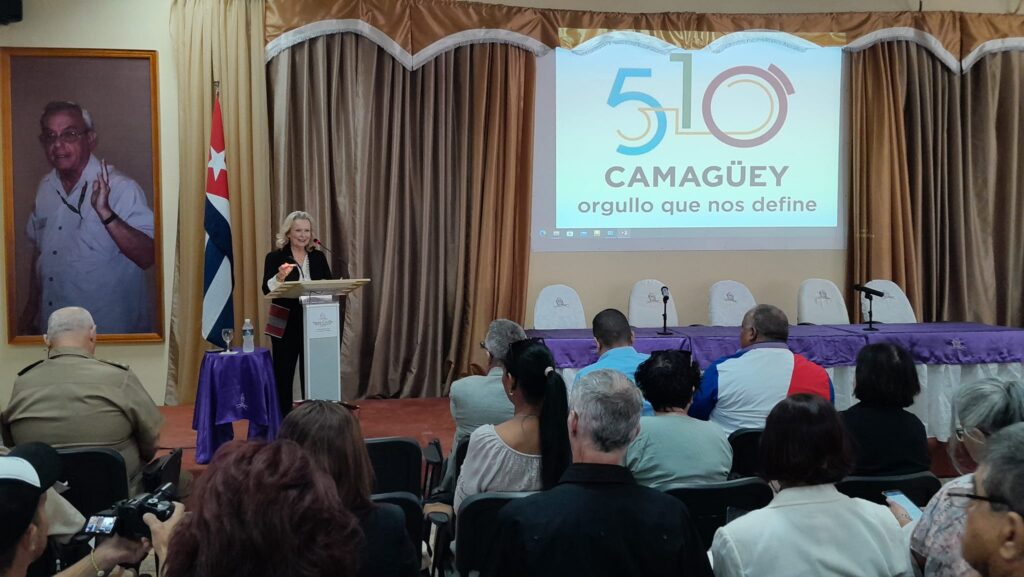![]()
That the shared knowledge be part of the tasks of the participating societies is the main purpose of the Symposium, aware that they think and work for the recipients who are, in the end, the owners of the city

Camagüey, Cuba, February 1st.- Anne Lemaistre, representative of UNESCO in Cuba and the Dominican Republic, was very pleased to visit the City of Tinajones, whose oldest segment is on the list of Intangible Heritage of Humanity.
When giving the opening conference of the XVI International Symposium on Challenges in the Management and Management of Cities, the director of the Regional Office of Culture shared tools and techniques that are implemented from several countries to advance the purpose of the organization.
He highlighted that it is a responsibility for UNESCO to accompany the actions of the largest of the Antilles where we can already talk about the Cuban school of management of historic centers, characterized by the rigor of the actions, the desire for social inclusion and from which It demonstrates the social role of heritage, not seeing it only for tourist purposes or commercial profit.
Among the initiatives he commented on are the Heritage Cities Network, with more than 200 cities from all regions of the world, in which aspects such as the challenges faced by historic urban areas are discussed and technical assistance is provided to countries.
Also the introduction of the concept of historical urban landscape, which encourages the expansion of the principles, «it is novel to be able to answer two essential questions: how to connect the historic center to its peripheries and what is the level of acceptable change in a living urban dynamic and changing”, he said.
Other challenges of the enclaves are to promote cultural policies with social and economic benefits for the populations, the creation of quality urban environments with public spaces where people can gather and the projection of sustainable cities from comprehensive policies based on culture.
Congratulating all the locals on the 510th anniversary, Anne Lemaistre concluded her speech, who will share during the next day with the representatives of the Network of Historian and Conservator Offices, which will meet tomorrow in the former town of Santa María del Puerto del The prince.
From an audiovisual in which the close ties of Eusebio Leal Spengler to the city of Camagüey were highlighted, the gratitude of his long-time colleagues was shown to the person who constitutes the main encourager of the safeguarding of Cuban heritage and history.
Anecdotes about his presence in the region, such as when he traveled from Havana alone to inaugurate the José Martí Park or the drive to renovate the old Plaza de Armas of the Andariega town, because Leal always lived proud of the City of Tinajones.
They recalled a fragment of his speech in 2019 for the town’s anniversary when he expressed that Camagüey rose to be a symbol of the Cuban nation, «we will look up to our founding fathers and among them is Ignacio Agramonte».
José Rodríguez Barreras, director of the Office of the Historian of the City of Camagüey, at the opening of the XVI International Symposium on Challenges in the Management and Management of Cities, highlighted the total support of local authorities and people for the institution’s actions to advance your goals.
He commented that it is relevant for the region to strengthen ties with UNESCO and other Latin American cities such as Ecuador, Uruguay and Mexico, from where specialists and researchers attend the event.
“We can now talk about a Cuban family in the preservation of heritage”, said Rodríguez Barrera. These spaces are necessary in the midst of the processes that the world is experiencing, in which the most affected are always the people, because here each experience is valid as it has a common cultural core.
That the shared knowledge be part of the tasks of the participating societies is the main purpose of the Symposium, aware that they think and work for the recipients who are, in the end, the owners of the city.
Text and photo: Diosmel Galano Oliver/Radio Camagüey